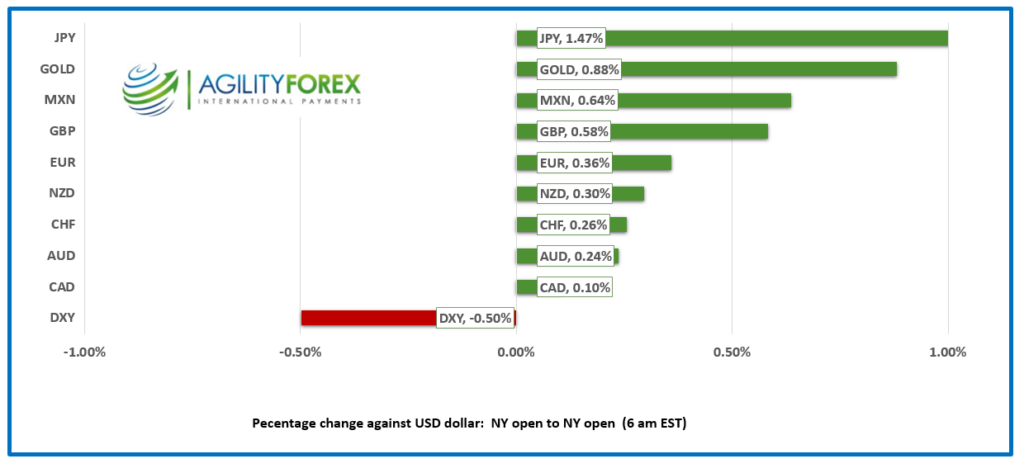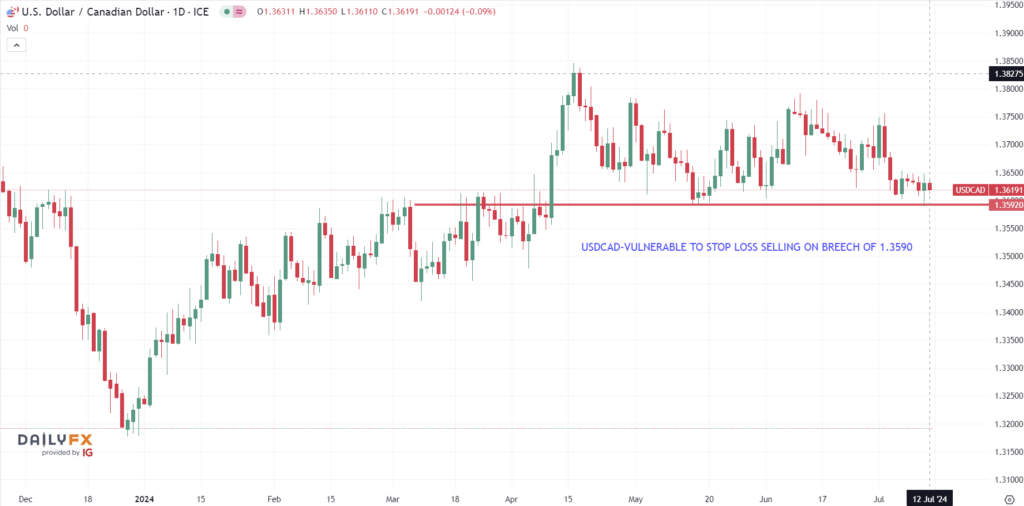
July 12, 2024
- Markets pricing 93% chance for Fed rate cut in September.
- Producer Price data and Michigan Consumer Confidence ahead.
- US dollar consolidating losses.
FX at a Glance

Source: IFXA/RP
USDCAD open 1.3617, overnight range 1.3511-1.3635, previous close 1.3634
USDCAD traded lower following the yesterday’s tame US inflation report, but its losses were minimal. That may have something to do with the perception that the closely linked Canadian and US economies suggest that what is bad for the US dollar is just as bad for the Loonie. USDCAD may have further downside due to large speculative short Canadian dollar positions. A decisive break below 1.3590 could trigger stop-loss selling and drive USDCAD to 1.3460.
Canada has been chastised by US Senators for freeloading on US defense spending. The Canadian government was so embarrassed that Justine Trudeau announced a plan to raise defence spending to 2.0% by 2034. He will be a drama teacher looking for work by then.
Canada’s Defense Minister Bill Blair proudly announced “steps to launching the process to acquire 12 submarines. The process looks like this:

WTI oil firmed in a 82.78-83.74 range supported by hopes for increased global demand from interest rate cuts. However, gains were capped by fears of reduced Chinese demand.
USDCAD Technicals
The intraday technicals are bearish below 1.3630 and looking for a test of major support at 1.3590 to extend losses to 1.3560. A break above 1.3630 suggests more 1.3590-1.3690 consolidation.
Longer term, the mid-April downtrend remains intact while below 1.3730 but the downtrend faces formidable support in the 1.3590 area, with additional support lurking in the 1.3540-60 zone.
For today USDCAD support is at 1.3590 and 1.3550. Resistance is at 1.3630 and 1.3690. Today’s range is 1.3550-1.3650
Chart: USDCAD Daily

Source: DailyFX
“I’d Like to Solve the Puzzle”
Bond traders are playing the Fed rate cut version of “Wheel of Fortune,” and after numerous wrong guesses, they are ready to solve the puzzle. Ninety-three percent of them shout “September 18.” Yesterday’s U.S. inflation report came in far below guesstimates, and analysts are chirping about how it is the best inflation performance since May 2020. Fed Chair Jerome Powell wanted more evidence that inflation was trending lower, and this report gave it to him.
Winners and Losers
The data sank the greenback, with the U.S. dollar index gapping down from 104.55 pre-data to 103.89 before it found a bottom. The U.S. 10-year Treasury yield plunged from 4.30% to 4.166%. Gold (XAUUSD) soared, rising from 2370.75 to 2423.70. Wall Street traded lower due to what is described as a “rotation out of large-cap tech stocks into smaller-cap cyclicals.”
Keeping Rate Cuts in Focus
U.S. producer prices rose 0.2% m/m in June (forecast 0.1%) and ex Food and energy prices rose 0.4% (forecast 0.2%). Michigan Consumer Confidence and Inflation expectations are on tap,
And the Dazed and Confused
Nothing says “it’s time to go” better than when the leader of the free world introduces an ally with not just the wrong name, but the name of an arch-villain. This link is from the NY Post. Click to see. Mr. Putin laughed so hard he nearly invaded Poland. That’s not all; if Biden is to be believed, his Vice President is Donald Trump, not Kamala Harris.
EURUSD
EURUSD rallied following the U.S. inflation numbers and consolidated the gains in a 1.0862-1.0892 range, with prices sitting at the top of that band in early NY trading. The drama around forming the next government in France is being overshadowed by the prospect of lower Fed rates, and that is underpinning EURUSD. EURUSD is bullish above 1.0810 but faces stiff resistance in the 1.0920 area.
GBPUSD
GBPUSD is trading with a bid and is at the top of its 1.2902-1.2962 range, with the rally fueled by U.S. rate cut hopes and by the recently revealed stronger-than-expected U.K. GDP growth. In additional recent comments by Bank of England Chief Economist Huw Pill suggest U.K. rates may remain unchanged in August. GBPUSD is now at a new high for 2024.
USDJPY
USDJPY is the poster child for FX volatility after plunging from 161.76 pre-CPI to 157.45 in the aftermath. The BoJ has not admitted intervening; the odds are about 99.99% that they did. USDJPY traded erratically in a 157.75-159.45 range due to the level of U.S. Treasuries and fear of more BoJ intervention.
AUDUSD and NZDUSD
AUDUSD was uninspired in a 0.6754-0.6779 range as support from broad U.S. dollar weakness gave way to concerns about sluggish Chinese economic growth following China’s disappointing import data. NZDUSD traded similarly in a 0.6076-0.6112 range, with prices weighed down by weak Electronic Card Retail Sales data. The 4.9% y/y drop in June retail sales suggests that the RBNZ will cut rates sooner than expected.
USDMXN
USDMXN traded lower yesterday and consolidated the losses in a 17.7107-17.8100 range. The prospect of lower U.S. interest rates and steady to unchanged Banxico rates fueled the selling pressure.
FX high, low, open (as of 6:00 am ET)

Source: Investing.com
China Snapshot
PBoC fix: 7.1315 vs exp. 7.2514 (prev. 7.1339)
Shanghai Shenzhen CSI 300 rose 0.12% to 3472.40.
China exports rose 8.6% y/y in June (forecast 8.0%) but Imports fell 2.3% y/y instead of rising 2.8% as predicted. The results suggest that the domestic economy is still struggling.
Chart: USDCNY and USDCNH

Source: Investing.com





